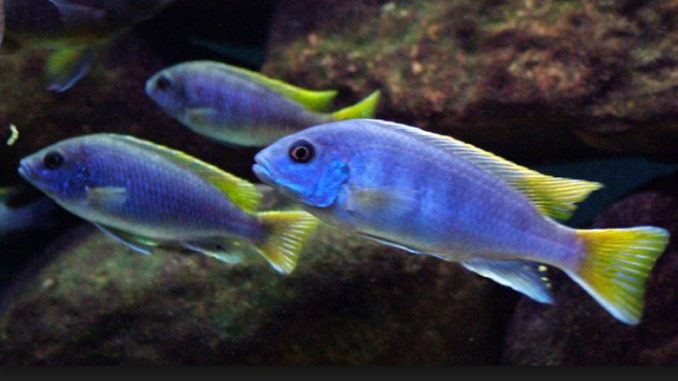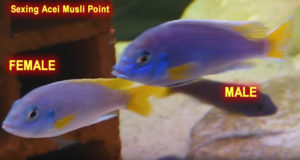
I always think the Acei Musli Point resembles a marine fish. They feature a striking bright blue colour to their body and head and a yellow tail. They look a little like a Damselfish. Acei’s are not territorial and will often school within an aquarium. One of their best features is that they tend to live a little higher up in strata terms of the aquarium making the overall look more busier.
Common Name(s) : Acei Musli Point,

Family : Cichlidae
Genus : Pseudotropheus
Species : Pseudotropheus elegans
Maximum Size : 13cm / 5.6 inches
Lifespan : 10-12 years
Aggression Level : Moderately Aggressive (6.5/10)
PREFERRED WATER CONDITIONS
Tank Size : 60 Litres +
PH : 7.5 – 8.5
Hardness : Moderate to Hard
Temperature : 23 – 26°C / 73.4–78.8 °F
TANK SET UP
Psuedotropheus Acei Musli Point cichlids inhabit the sandy areas of Lake Malawi, therefore they are not demanding many special needs within an aquarium. Coral Sand with some rockery is best to emulate their natural habitat.
SUITABLE TANK MATES
- Other African cichlids (of similar size)
- Clown Loaches, Featherfin Catfish, Cuckoo Catfish, Bristlenose Catfish, Plecos, Ghost Knives
- They can also sometimes live with barbs, American cichlids, Larger Gourami’s, Eels, Silver & Golden Perch, larger sharks, silver dollar and yabbies.
DIET
Acei Musli Point cichlids are are carnivores – in the wild they feed on small crustaceans and cichlid fry. In the aquarium provide them a high quality cichlid pellet or flake. Most of their natural diet is meat based so ensure you also feed Acei’s some frozen brine shrimp or frozen bloodworms periodically.
SEXING AND BREEDING
Acei Musli Point cichlids are not easy to sex. Both sexes exhibit similar colouration and possess egg spots in the anal fin. Male fish however tend to grow larger and are more brightly coloured when 5cm plus in size.
The egg spots in males tend to be more numerous and more intense in colour, but note that both males and females can exhibit egg spots. Males tend to be a little leaner than a ever so slightly deeper bodied female.
The easiest way to sex it is by observing their behaviour in the aquarium. As with other mbuna males are the more territorial sex and are often seen chasing females and other species in the tank.
When the breed these fish are known as Ovophiles. Ovophiles are mouthbrooding members of the Cichlidae family of fish (cichlids). Ovophiles dig pits or holes in which the female lays eggs. The female lays eggs in this pit and then immediately takes the eggs into her mouth. The male then fertilizes the eggs in the female’s mouth.
In some species, the male’s anal fin is covered with circular markings that, to a female, look confusingly like eggs. Female will attempt to bring the male’s tail into their mouth and, at the right moment, the male will ejaculate into their mouths, fertilizing the eggs.
Examples including the include the Aulonocara, Haplochromis and Pseudotropheus, and Labidochromis caeruleus.
